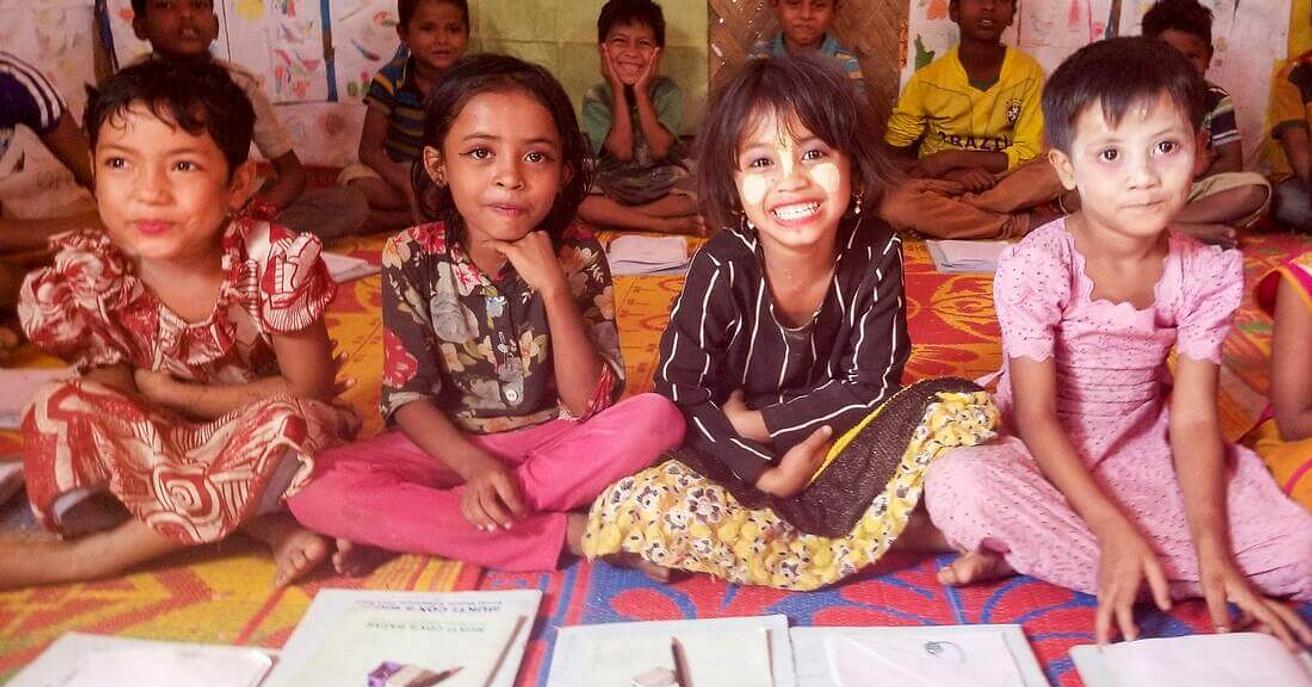Over 18 months since the start of the Rohingya refugee crisis, despite the wealth of agencies investing in education for children in Kutupalong, only about 45% of refugee children currently have access to education in the camps.
Navigating the multiple layers of bureaucracy and negotiating building space in the densely populated camp has made provision a huge challenge, and as the crisis has become protracted, the promised formal curriculum for refugee children was postponed by the government for over a year.
Despite these obstacles, Children on the Edge have successfully established 75 Learning Centres which have all been running five days a week since June 2018, providing education for 7,500 children.
150 Bangladesh and Rohingya teachers are fully trained and running classes each day. They have been trained in communication, child rights, health, hygiene, first aid, identifying trauma, classroom management and how to make learning engaging.
This has had a brilliant impact on the children, who have adapted their behavior quickly to the classroom routine, established good friendships, developed a strong sense of safety and belonging and enjoyed learning letters, numbers, and languages through songs, rhymes, and dances.
Toslina (pictured) has been teaching for three months and says “The biggest success has been learning about each child in my class. Knowing their names. Knowing who they are. I care about them very much. For most of the kids, they had never been to school before. Being in our schools helps them to feel safe and calm. They feel like they belong in school now”.

Restricted this year to teaching from only basic texts, staff have begun to lay the foundation for an education program which will be both innovative and effective in 2019.
The unique traits of these Centres are as follows:
1. The physical space is distinct from other Centres in the camp
Bamboo fences separate the children from the hustle and bustle of camp life and an array of flowers and vines have been planted to cover the walls. This creates a green barrier, allowing children to separate themselves from the harsh realities outside.
Somira, aged 8 says “I help my teacher water the plants. Taking care of plants is one of my favorite things. I like the garden space and I want to add more flowers and maybe some vegetables. We had a big garden in my old house. We had more pumpkins than we could eat”.

2. We're introducing innovative methods to overcome language limitations
The greatest barrier to education here is the government’s policy on language. The printed text must be in Burmese and English, which are not spoken by almost any refugees or local residents. To overcome this, we will be introducing multimedia content. Battery-powered projectors will deliver lessons on academic subjects, health/hygiene, problem-solving, creative thinking and child rights.
We are currently developing these materials, ready for delivery in March 2019. We are also working on a nonlinguistic curriculum to teach educational concepts, problem-solving, and critical thinking without relying on a written language.

3. We are developing a sense of ownership of the schools by the children
Each building is decorated with the handprints of the students accompanied by their names. Once inside, the Centres are a riot of color, covered from floor to ceiling with the children’s artwork and decorations.

4. All Centres are equipped with a well-stocked First Aid kit
Teachers receive training that prepares them to identify serious health concerns in students, know when and how to refer them to health professionals and learn how to utilize the materials in the First Aid kits.

5. We are ensuring children’s voices are heard
In January 2019, the refugee camps’ first child-produced newsletter was published, containing their artwork, stories, and poems. This generated a great deal of excitement amongst the children, who report they frequently feel anonymous and forgotten amidst the sprawl of the camp. Teacher Sanjil said “Some of the kids in my class have their artwork in the school newsletter. They were very proud of this”.

Quarterly Child Council meetings are also facilitated at each Centre and modeled on those established in the Cox’s Bazar Community Schools.
We are confident that our prior experience in the camp and a unique perspective on education with Rohingya children will allow us to set the benchmark for quality education in the refugee camp areas in the coming year.
To know more about Children On The Edge, explore their innovation page here.

